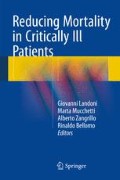Abstract
Multiple organ dysfunction syndrome is the leading cause of mortality in intensive care units and is precipitated by tissue hypoperfusion. The optimization of oxygen delivery to supranormal levels by infusion of fluids, red blood cells and vasoactive drugs as needed has been adopted in an effort to avoid and reverse this tissue hypoxia and resultant organ damage. Both hemodynamic (cardiac index ≥ 4.5 L/min/m2) and oxygen transport (oxygen delivery ≥ 600mls/min/m2, oxygen consumption ≥ 170mls/min/m2) targets have been extensively investigated, however supranormal elevation of oxygen delivery does not improve overall outcome in critically ill patients. Furthermore, it is often difficult to achieve targets of increased oxygen consumption, with attempts to do this proving detrimental, as demonstrated in Hayes’ work. Early resuscitation, however, appears to be beneficial and a favorable response to hemodynamic optimization may predict survival.
Access this chapter
Tax calculation will be finalised at checkout
Purchases are for personal use only
References
Sakr Y, Lobo SM, Moreno RP, Gerlach H, Ranieri VM, Michalopoulos A, Vincent JL, The SOAP Investigators (2012) Patterns and early evolution of organ failure in the intensive care unit and their relation to outcome. Crit Care 16(6):R222
Seely AJ, Christou NV (2000) Multiple organ dysfunction syndrome: exploring the paradigm of complex nonlinear systems. Crit Care Med 28:2193–2200
Third European Consensus Conference in Intensive Care Medicine. Tissue hypoxia: how to detect, how to correct, how to prevent. Societe de Reanimation de Langue Franchise. The American Thoracic Society. European Society of Intensive Care Medicine (1996) Am J Respir Crit Care Med. 154:1573–1578
Shoemaker WC, Appel PL, Kram HB (1992) Role of oxygen debt in the development of organ failure sepsis, and death in high-risk surgical patients. Chest 102(1):208–215
Shoemaker WC, Montgomery ES, Kaplan E, Elwyn DH (1973) Physiologic patterns in surviving and nonsurviving shock patients use of sequential cardiorespiratory variables in defining criteria for therapeutic goals and early warning of death. Arch Surg 106(5):630–636
Bland RD, Shoemaker WC, Abraham E, Cobo JC (1985) Hemodynamic and oxygen transport patterns in surviving and nonsurviving postoperative patients. Crit Care Med 13(2):85–90
Shoemaker WC, Appel PL, Kram HB, Waxman K, Lee TS (1988) Prospective trial of supranormal values of survivors as therapeutic goals in high-risk surgical patients. Chest 94(6):1176–1186
Edwards JD, Brown GC, Nightingale P, Slater RM, Faragher EB (1989) Use of survivors’ cardiorespiratory values as therapeutic goals in septic shock. Crit Care Med 17(11):1098–1103
Tuchschmidt J, Fried J, Astiz M, Rackow E (1992) Elevation delivery of cardiac output improves outcome and oxygen in septic shock. Chest 102(1):216–220
Yu M, Levy M, Smith P, Takiguchi S, Miyasaki A, Myers S (1993) Effect of maximising oxygen delivery on morbidity and mortality rates in critically ill patients: a prospective, randomised, controlled study. Crit Care Med 21(6):830–838
Hayes M, Timmins A, Yau E, Palazzo M, Hinds C, Watson D (1994) Elevation of systemic oxygen delivery in critically ill patients. N Engl J Med 3001(24):1717–1722
Gattinoni L, Brazzi L, Pelosi P et al (1995) A trial of goal-oriented hemodynamic therapy in critically ill patients. N Engl J Med 333(16):1025–1032
Heyland DK, Cook DJ, King D, Kernerman P, Brun-Buisson C (1996) Maximizing oxygen delivery in critically ill patients: a methodologic appraisal of the evidence. Crit Care Med 24(3):517–524
Rosser DM, Stidwill RP, Jacobson D, Singer M (1995) Oxygen tension in the bladder epithelium increases in both high and low output endotoxemic sepsis. J Appl Physiol 79:1878–1882
Boekstegers P, Weidenhofer S, Pilz G, Werdan K (1991) Peripheral oxygen availability within skeletal muscle in sepsis and septic shock: comparison to limited infection and cardiogenic shock. Infection 19:317–323
Brealey D, Brand M, Hargreaves I et al (2002) Mechanisms of disease Association between mitochondrial dysfunction and severity and outcome of septic shock. Lancet 360:219–223
Mongardon N, Dyson A, Singer M (2009) Is MOF an outcome parameter or a transient, adaptive state in critical illness? Curr Opin Crit Care 15(5):431–436
Vallet B, Chopin C, Curtis SE, Dupuis BA, Fourrier F, Mehdaoui H, LeRoy B, Rime A, Santre C, Herbecq P et al (1993) Prognostic value of the dobutamine test in patients with sepsis syndrome and normal lactate values: a prospective, multicenter study. Crit Care Med 21(12):1868–1875
Boyd O, Grounds RM, Bennett ED (1993) A randomised clinical trial of the effect of deliberate perioperative increase of oxygen delivery on mortality in high risk surgical patients. JAMA 270(22):2699–2707
Lundberg JS, Perl TM, Wiblin T et al (1998) Septic shock: an analysis of outcomes for patients with onset on hospital wards versus intensive care units. Crit Care Med 26(6):1020–1024
Wilson J, Woods I, Fawcett J, Whall R, Dibb W, Morris C, McManus E (1999) Reducing the risk of major elective surgery: randomised controlled trial of preoperative optimisation of oxygen delivery. BMJ 318(7191):1099–1103
Rivers E, Nguyen B, Havstad S et al (2001) Early goal-directed therapy in the treatment of severe sepsis and septic shock. N Engl J Med 345(19):1368–1377
Dellinger RP, Levy MM, Carlet JM et al (2008) Surviving Sepsis Campaign: international guidelines for management of severe sepsis and septic shock. Intensive Care Med 34(1):17–60
Singer M, Glynne P (2005) Treating critical illness: the importance of first doing no harm. PLoS Med 2(6):e167, Epub 2005 Jun 28
Author information
Authors and Affiliations
Corresponding author
Editor information
Editors and Affiliations
Rights and permissions
Copyright information
© 2015 Springer International Publishing Switzerland
About this chapter
Cite this chapter
Tatham, K.C., Cattlin, C.S., Hayes, M.A. (2015). Supranormal Elevation of Systemic Oxygen Delivery in Critically Ill Patients. In: Landoni, G., Mucchetti, M., Zangrillo, A., Bellomo, R. (eds) Reducing Mortality in Critically Ill Patients. Springer, Cham. https://doi.org/10.1007/978-3-319-17515-7_12
Download citation
DOI: https://doi.org/10.1007/978-3-319-17515-7_12
Publisher Name: Springer, Cham
Print ISBN: 978-3-319-17514-0
Online ISBN: 978-3-319-17515-7
eBook Packages: MedicineMedicine (R0)

